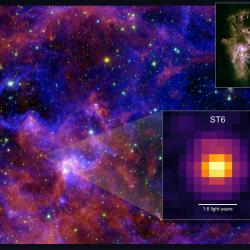NASA Renames Swift Mission in Honor of Neil Gehrels
NASA’s newly renamed Neil Gehrels Swift Observatory honors founding principal investigator of versatile satellite mission, who died in 2017
On January 10, 2018, at the 231st American Astronomical Society Meeting in Washington, D.C., NASA announced the renaming of the spacecraft formerly known as the Swift Gamma-ray Burst Mission. The mission is now formally known as the Neil Gehrels Swift Observatory, in honor of Neil Gehrels, who helped develop Swift and served as its principal investigator until his death on February 6, 2017.
For 13 years, Swift has conducted a broad array of science investigations—including monitoring comets; studying stars hosting exoplanets; and catching outbursts from supernovas, neutron stars and black holes.
Gehrels was a College Park Professor in the University of Maryland Department of Astronomy. He also served as chief of the Astroparticle Physics Laboratory at NASA’s Goddard Space Flight Center and was a founding member of the Joint Space-Science Institute, a collaboration between UMD’s Departments of Astronomy and Physics and NASA Goddard.
"The Neil Gehrels Swift Observatory is a name that reflects Swift's current status as the go-to facility for rapid-response, multiwavelength follow-up of time-variable sources," said Paul Hertz, director of NASA's Astrophysics Division. "With Swift, Neil helped usher in the era of time-domain astronomy."
Swift's rapid scheduling capability, plus its trio of telescopes covering optical to gamma-ray wavelengths, continues to deliver important contributions to the study of gamma-ray bursts—the most powerful explosions in the universe—while monitoring how astronomical objects as diverse as comets, stars and galaxies change over time.
"Swift is still going strong, and we continue to receive four urgent 'target-of-opportunity' observing requests from the broader astronomical community each day," said Bradley Cenko, who was recently appointed as the Swift mission’s principal investigator. Cenko is also an adjunct assistant professor of astronomy at UMD and a fellow at the Joint Space-Science Institute. "Neil’s leadership and vision continue to guide the project, and we can think of no better way to honor this legacy than with the new name."
A pioneer in the study of gamma-ray bursts—high-energy radiation blasts that come from deep space—Gehrels worked as a project scientist and investigator on several notable missions, including the Fermi Gamma-ray Space Telescope, the Wide Field Infrared Survey Telescope, the Compton Gamma Ray Observatory and the Swift Gamma-ray Burst Mission. Under Gehrel’s leadership, the Swift team—which set out to determine the origin of these powerful explosions in the universe—detected 1,000 such observations between 2004 and 2015. He also served as a member of the Laser Interferometer Gravitational-Wave Observatory (LIGO) Scientific Collaboration that announced the detection of gravitational waves in February 2016.
“Dr. Gehrels led space telescope missions that have revolutionized our understanding of many of the most energetic phenomena in the universe,” said Stuart Vogel, professor and former chair of the Department of Astronomy at UMD. “He was also a great supporter of the University of Maryland and a wonderful mentor to many of our students.”
Gehrels received many awards for his leadership and research accomplishments. A few days before his death, Gehrels was named a 2017 Dan David Prize laureate for the Future Time Dimension in the field of astronomy, along with Shrinivas Kulkarni of Caltech and Andrzej Udalski of Warsaw University. Each year, three Dan David prizes (for Past, Present and Future Time Dimensions) worth $1 million each are awarded “for achievements having an outstanding scientific, technological, cultural or social impact on our world.”
Honoring the request of Gehrels’ family, the Dan David Foundation donated Gehrels' share of the prize to UMD for the Neil Gehrels Memorial Student Support Endowment in Astrophysics, which supports students and postdocs engaged in research with UMD and NASA Goddard astrophysicists.
In addition to the Dan David Prize, Gehrels received numerous other honors, including the NASA Exceptional Scientific Achievement Medal, the NASA Outstanding Leadership Medal and NASA Goddard's John C. Lindsay Memorial Award. He and the Swift team received the 2007 Rossi Prize from the American Astronomical Society and the 2009 Henry Draper Medal from the National Academy of Sciences.
He was elected to the National Academy of Sciences and the American Academy of Arts and Sciences, named fellow of the American Association for the Advancement of Science and the American Physical Society, and elected honorary fellow of the Royal Astronomical Society.
###
This release was adapted from text provided by NASA’s Goddard Space Flight Center.
Media Relations Contact: Matthew Wright, 301-405-9267, mewright@umd.edu
University of Maryland
College of Computer, Mathematical, and Natural Sciences
2300 Symons Hall
College Park, MD 20742
www.cmns.umd.edu
@UMDscience
About the College of Computer, Mathematical, and Natural Sciences
The College of Computer, Mathematical, and Natural Sciences at the University of Maryland educates more than 7,000 future scientific leaders in its undergraduate and graduate programs each year. The college's 10 departments and more than a dozen interdisciplinary research centers foster scientific discovery with annual sponsored research funding exceeding $150 million.







